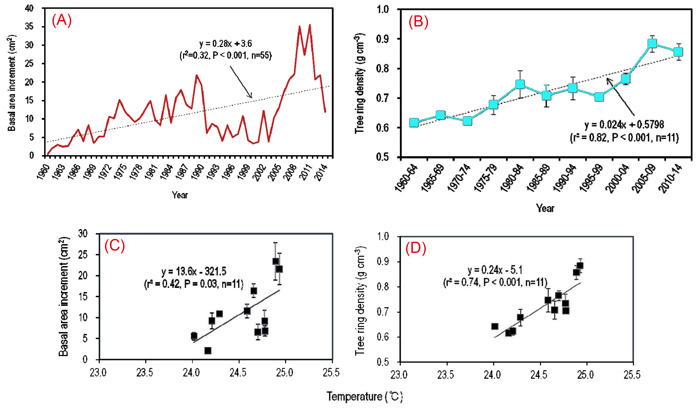| Follow @co2science |
Paper Reviewed
Viet, H.D., Tu, K.N., Kwak, J.-H. and Choi, W.-J. 2018. Warming increased nitrogen availability and tree growth during the last five decades as revealed by annual ring data of Pinus merkusii in central Vietnam. Communications in Soil Science and Plant Analysis 49: 416-425.
In explaining the reason for their study, Viet et al. (2018) write that few studies exist that explore "the relationship between annual [tree-] ring width and climatic variables" in Vietnam. And of those that do exist, none utilize Merkus Pine (Pinus merkusii) despite its prevalence in the region. It thus became the authors' research goal to fill this data gap by conducting a dendroclimatic study using P. merkusii to determine the response of this forest species to temperature and rainfall trends over the period 1960-2014.
To meet their objective, Viet et al. sampled and analyzed P. merkusii trees that were growing naturally in a tropical forest site in Quang Son commune, Quang Trach district, Quang Binh province in central Vietnam. Various tree ring parameters were then statistically compared with climatic variables obtained from a nearby meteorological station located 2 km from the forest site.
Results of the study reveal there was an increase in both tree-ring density and basal areal increment across the 55-year period of analysis (see Figure 1a,b). Viet et al. also report that a general warming trend occurred at the forest sampling site with the mean annual temperature rising 0.18°C per decade, which warming trend positively impacted both tree basal area increment and tree ring density (see Figure 1c,d below). In contrast, rainfall was only very weakly correlated with tree-ring parameters.
In light of the above findings, Viet et al. state that the "warmer conditions likely increased tree growth as photosynthesis rates of trees are temperature dependent when the increased in temperature does not exceed the optimum range (ca. 30°C) and other environmental constraints such as water availability do not limit tree growth." Additionally, they say the rising temperatures may have enhanced soil nitrogen mineralization, which could have increased nitrogen availability for the trees, thereby promoting their growth.
Whatever the case may be, one thing is certain; the increasing temperatures of the past 55 years have not stunted, halted or harmed the growth of this tropical forest tree. Instead, they have enhanced it. And in our view, that is a positive outcome that is just the opposite of what climate alarmists claim should be occurring in response to rising temperatures.

Figure 1. Upper Panels: Variations in (a) basal area increment and (b) tree-ring density of P. merkusii between 1960 and 2014. Lower Panels: Correlation between (c) temperature and tree basal area increment and correlation between (d) temperature and tree-ring density. Source: Viet et al. 2018.




